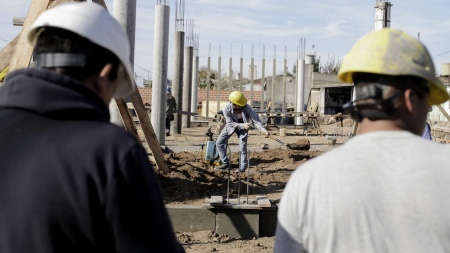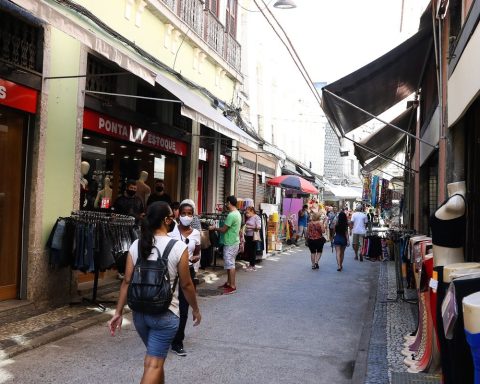The construction sector reached a historical record of workers last November, with 460,386 jobs, while the industry accumulated 29 months of growth in its jobs that totaled 93,000 in the penultimate month of 2022 and are 10,000 away from recovering what was lost during the Government of Mauricio Macri.
According to figures from the National Institute of Statistics and Censuses (Indec), the 460,386 jobs in construction imply a historical record for the sector after what happened in June 2015, with 458,433 jobs, and in November 2017, with 458,147 ; which were the two highest marks so far.
This contrasts with the latest data released by INDEC that industrial activity grew 4.3% over the past year but after having presented a drop of 2.7% in December compared to the same month of 2021.
Meanwhile, activity in the construction sector accumulated an improvement of 3.5% compared to the previous year, after closing December with a decrease of 10.6% year-on-year.
In the last month of last year, the manufacturing sector showed a decline of 1.2% compared to November, and construction a drop of 3.5%.

However, Last year both sectors showed a strong process of recovering jobs lost between 2016 and 2019, in addition to the creation of new jobs in the case of construction.
“The development of investment in public works has multiple impacts and one of them is linked to the growth in jobs. The recovery of employment is one of the central axes of our management and this process cannot be understood without infrastructure”indicated to Télam the national director of Transparency of the Ministry of Public Works, Roxana Mazzola.
In addition, he stressed that “if a year-on-year comparison is made between November 2021 and the same month of 2022, an exponential growth can be glimpsed in this area”, and specified that “a 16.3% increase is appreciated year on year and an increase of 2.7% month-on-month”.
The official remarked that “these data clearly mark the direction of the policies promoted by the Ministry and its commitment to a public work that includes more and more working people.”
“In 2016, more than 42,000 jobs were lost compared to 2015, which meant the biggest setback before the arrival of the Covid-19 pandemic.. Despite the negative consequences that the mandatory confinement generated in construction, more than two years of uninterrupted increase in jobs can be seenwith the exception of December 2020 and 2021 that had a drop between -1% and -2%, usual in the summer period,” Mazzola highlighted.
He stressed that “at the federal level, the panorama is even more encouraging”, and specified that “according to the Institute of Statistics and Registration of the Construction Industry (Ieric), there were 21 jurisdictions that increased their volume of employment compared to the previous month”.
In this regard, he pointed out that “among those with the highest monthly growth, La Pampa (8.5%), Neuquén (6.7%), Tierra del Fuego (6%) and Catamarca (5.8%) stand out.”
“Finally, an interesting fact to take into account is related to the unemployment rate in the general labor market. In the third quarter of 2022, it returned to single digits (7.1%) and, in this way, it remains almost unchanged compared to previous semesters. In turn, it is consolidated as the sixth consecutive period to register below two digits,” the official concluded.
For his part, Registered industrial employment accumulated 29 months of monthly growth in November since July 2020, incorporating more than 93,000 workers, according to the Center for Argentine Political Economy (CEPA).
“However, 10,000 positions remain to be recovered to reach the amount lost during the Cambiemos administration,” they explained from the study center led by Hernán Letcher.
“However, 10,000 positions remain to be recovered to reach the amount lost during the Cambiemos administration,” they explained from the study center led by Hernán Letcher
They pointed out that “from June of last year onwards, industrial production fell 2%”, but stressed that “this process was accompanied by an increase in employment in every month, accounting for more than 16,000 jobs in that period”.
According to CEPA, the sectors that grew the most in terms of job creation within the industry were food, chemical products, other metal products, automotive and textile production.
They highlight “the policy of generating data and information on how much employment public works generate”
The national director of Transparency of the Ministry of Public Works, Roxana Mazzola, highlighted that the portfolio has been developing a policy of “generation of data and information on how much employment public works generate”, with the aim of “producing typologies that are labour-intensive”.
“The Ministry of Public Works has been developing a policy for generating data and information on how much employment public works generate. One of the developments it has done is to generate a public works estimator that measures the number of direct and indirect jobs and by gender that are produced“, Mazzola pointed out to Télam.
He also stressed that “This has been highlighted by the IDB (Inter-American Development Bank) in a recent meeting held at the Latin American level”because he remarked that “the only countries that have been carrying out these developments and are at the forefront in this regard are Argentina, Chile and Paraguay.”
“In this policy that is being strengthened and developed for transparency and the generation of evidence for decision-making from the Ministry, what we have been propping up is a participatory space that is the Public Works Observatory, where Uocra, Camarco, national universities, Cippec and Poder Ciudadano”, highlighted the official.
He explained that “one of the axes that work is the generation of employment in the sector and all the evidence that all these areas have been producing around the subject.”
Mazzola affirmed that “the impact of public works occurs in the generation of very specific employment”, for which the objective is “to generate typologies that are labor intensive, such as the Argentina Hace plan”.
“Based on the estimator we built, we were able to identify that this program, of all the types, is the most labor-intensive and rapidly generating employment,” said the official, who also highlighted “the type of care infrastructure works , which we have been developing as an innovative initiative at the Latin American level from the Ministry”.
In this sense, he stressed that this includes “the strengthening of the health infrastructure, child development centers and spaces for youth, which are also highly intensive in the generation of jobs.”
“Along with this, there are the large structural works that the Ministry has been propping up that can be followed and controlled by citizens on the Investment Map platform,” Mazzola remarked.


















